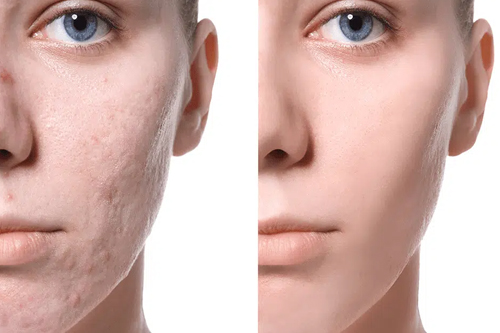
Acne Scar Removal by Laser Treatment In Nagpur refers to a dermatological procedure. thus utilizes laser technology to reduce or eliminate the appearance of acne scars on the skin. This method is often considere for individuals who have persistent or acne scars that haven’t responde well to other treatments.
Laser treatments for acne scar removal aim to minimize the appearance of scars and improve skin texture. Thus, enhancing overall skin quality. It’s important to consult with a qualified skincare to determine the most suitable laser approach base on individual skin needs.
WHAT CAUSES ACNE SCARRING?
Cystic Acne: Firstly, Cystic acne is a severe form of acne that involves deep, painful cysts. Thus, The inflammation and infection associated with cystic acne can lead to more significant damage to the skin . an increase likelihood of scarring.
Picking or Squeezing Pimples: once, Manipulating or picking at acne lesions can exacerbate inflammation and damage the surrounding skin.thus, increasing the risk of scarring. Squeezing pimples can push bacteria and debris deeper into the skin, causing more extensive damage.
Delaye or Inadequate Treatment: Failure to address acne promptly or using ineffective treatments can contribute to the development of scars. Proper acne management and treatment reduce the severity of outbreaks and minimize the risk of scarring.
Genetics: Some individuals may be genetically predisposed to developing acne scars.Thus, Factors such as skin type, collagen production, and the body’s healing response can be influence by genetic factors.
Hormonal Changes: Thus, Hormonal fluctuations, such as those during puberty, menstruation, pregnancy, or hormonal disorders.Therefore, can contribute to the development of acne and, subsequently, scarring.
Severity of Acne Lesions: The more severe the acne lesions, the higher the likelihood of scarring. Nodules and cysts, which are deeper and more inflame, are more prone to causing lasting damage to the skin.
Lack of Sun Protection: Sun exposure can exacerbate the appearance of scars by causing pigmentation changes and scars more noticeable. Using sunscreen and protecting the skin from harmful UV rays is essential, especially for individuals with acne scars.
How the Process Works
- Topical Anesthesia or Cooling Gel: Firstly, Depending on the type of laser use and the depth of the treatment. the patient may be given a topical anesthetic cream .thus, cooling gel to numb the treatment area and enhance comfort during the procedure.
- Laser Treatment: There are different types of lasers use for acne scar removal, including fractional lasers and ablative lasers. The choice of laser depends on the specific characteristics of the scars.
- Fractional Lasers: These lasers target small, fractionate areas of the skin, stimulating collagen production. promoting the growth of new, healthy skin cells. This helps to improve the appearance of scars over time.
- Ablative Lasers: once, These lasers remove thin layers of skin, allowing new, smoother skin to replace the scarre tissue. Ablative lasers are often more intense and may require a longer recovery period.
- Collagen Stimulation: thus, The laser energy penetrates the skin, reaching the deeper layers where collagen production is stimulate.thus, Collagen is a protein that plays a crucial role in maintaining skin elasticity and promoting a smoother complexion.
- Healing Process: After the laser treatment, the skin will undergo a healing process. Patients may experience redness, swelling, and mild discomfort, similar to a sunburn. It’s essential to follow post-treatment care instructions provide by the practitioner.
- Multiple Sessions: Achieving optimal results may require multiple laser sessions space several weeks apart. The number of sessions depends on the severity of the acne scars and the type of laser use.
- Post-Treatment Care: Patients are typically advised to protect their skin from sun exposure, and use gentle skincare products. follow any specific post-treatment instructions to promote healing and reduce the risk of complications.
